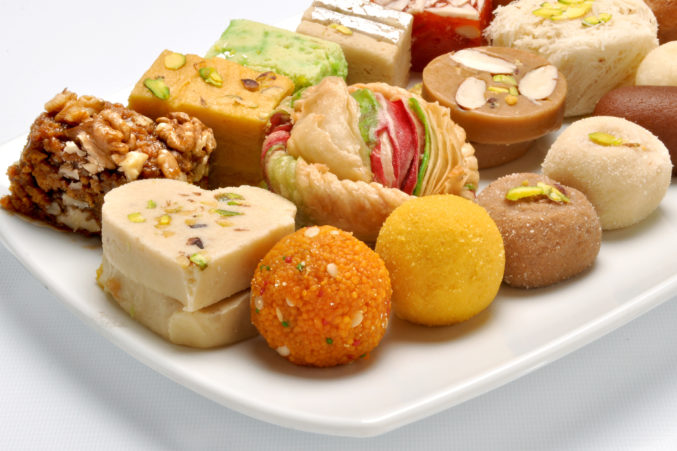Saffron and Cardamom - The Royal Spices of Indian Desserts and Sweets
By Conchita de Souza

What images come to your mind when you hear the sweetest of words - dessert? Do you think of creamy scoops of gelato stacked up in freshly-made cones, hot out of the waffle-maker? Or a gooey chocolate brownie with a side of ice cream and fresh strawberries? Maybe for you, dessert spells decadent cheesecakes with buttery biscuit bases or flaky pastries, oozing with a tangy lemon cream filling. How many of you think of spices when it comes to dessert? In fact, certain spices, when added to sweet dishes, help to highlight the flavours of the dish, and slightly temper the sweetness.
The concept of adding spices to sweet dishes, is traditional as it is delicious. You can take an ordinary banana bread to new heights by just adding a dash of cinnamon and/or nutmeg powders. A sprinkle of dried ginger or the addition of cloves into puddings or cakes add an extra element of undeniably tasty goodness. Have you ever tried chilli hot chocolate - a remedial concoction invented by the Mayans of ancient Mexico? In India, two spices dominate the sugary realm of sweets and desserts and add an extra dimension of flavour, with the subtle release of their aromas. They are used in the preparation of meats, rices and curries and also happen to be numbers one and three on the list of the most expenses spices in the world. Without further ado, let us introduce you to these spices, both of which pack a powerful punch when standing alone, but once mixed with the sweet touch of the almighty sugar, are tamed like a lioness in a cage.
SAFFRON
The most expensive spice on earth, 90% of saffron’s production comes from Iran. It takes 100 kg of crocus sativa (the saffron flower) to produce just 1kg of dried saffron. The reason saffron is so expensive, is because the harvesting process is labour-intensive, and limited to a specific season; autumn. The flower, a beautiful and light shade of mauve, grows in places which have cold winters and hot and warm and dry summers (most Aussies experience wet summers thanks to the frequent storms, so no, saffron won’t grow like a breeze here). Click here, if you would like to know more about this stunner of a spice.
Though saffron might be a spice quite temperamental in nature, it is added to many a sweet dish for colour and fragrance.
-
Kheer - This dish resembles rice pudding in texture and even in taste, and in India, is a popular dish to serve during festivals. Rice is cooked in a pot of boiling milk, until it reduces into a thick pudding-like texture. Sugar is added along with a delicate balance of nuts, raisins, cardamom powder, rosewater and saffron strands soaked in milk. All of these ingredients, although added in very small amounts, create texture, aroma and colour to what would otherwise be, a very simple dish. Here is a recipe for Kheer, which you can make from the comfort of your own kitchen!

PC: www.milkmaid.in
-
Peda - Another festive dessert, popular especially during Diwali, are pedas, which are made from two key ingredients; milk, that has been reduced to a solid (known as khoya or mawa in Hindi), and sugar. Pedas resemble fudge in texture, soft when bitten into, and are slightly grainy due to the milk solids. Saffron is added once the milk has reduced and it turns into a dough. Pedas are garnished with slivered pistachios, and crushed cardamom and should always be eaten in twos (for no other reason than that they taste out of this world).

PC: www.hungryforever.com
- Jalebis - Spiraled, sugary, syrupy and sweet - jelabis are a colourful treat to share with anyone you meet! Rhyming and alliteration aside, this sweet’s addictive element stems from the fact that it is deep fried. And if you go by my food philosophy of ‘anything that is deep fried is bound to taste good’, then you’re probably already salivating. Jalebis involve fermenting a batter of flour, chickpea flour, turmeric and baking soda overnight, piping the spiral shaped batter into hot oil, and then dunking them in a sugary syrup infused with saffron and cardamom. They are best enjoyed warm, along with some milk or rabri (reduced, sweetened milk) on the side.

PC: theweddingplannersindia.com
CARDAMOM
Cardamom may not possess the same element of preciousness as does saffron, but it does happen to be the third costliest spice in the world (read on to discover what is the second most expensive spice in the world). The spice is encased in a green papery pod and contains small black seeds inside. Green cardamom is used more widely than its bigger brother Black Cardamom, which is much larger in size. Green cardamom features much more generously and more frequently in Indian desserts and its aroma and flavour are welcoming and familiar, like visiting an old friend after spending many years apart. Below are some of my all time favourite Indian sweets, all of which incorporate cardamom in different manners.
-
Gulab Jamun - Gulab Jamuns are an absolute treat to eat. They are deep-fried balls made from a mixture of semolina, plain flour and evaporated milk solids (khoya) and then soaked in a thick and clear sugary syrup, perfumed with rose water. Cardamom can either be added in powdered form when making the balls, or added in whole to the syrup. My dad usually prefers the latter method, as the flavour of the spice is incorporated with more subtlety. My favourite way to eat gulab jamuns is served hot with a side of vanilla ice cream.

The most delightful of them all; gulab jamuns
- Gajar Halwa - This dessert is a speciality in the winter season and requires the use of red carrots, which are sweeter in taste than its orange counterparts. It can be a laborious dessert to make, because it involves grating kilos of carrots (and usually grating part of your fingers as well) and cooking them, as we saw with the kheer dish, with milk and sugar until the carrots have absorbed the milk entirely. (The Thermomix makes this a breeze. If you would like the recipe, please write to us). Cardamom is added in powdered form, once three quarters of the milk has evaporated. Being a winter special, it is best served warm and won’t stay long in your fridge because it is lip-smackingly delightful.

Who would have thought carrots could taste so good outside of a salad? ;-)
- Kulfi - Kulfi takes me back to drawn-out Indian summers where the sun’s stroke leaves you in a state of delirium and all your tastebuds crave are cold, icy and chilled sensations to soothe the inferno inside your body. Kulfi is Indian ice-cream, which acquires a different texture than regular ice-cream, because it is not churned. Traditional kulfi recipes incorporate powdered cardamom, which compliments its nutty-like taste. We have a simple recipe for Pistachio Kulfi, which is a perfect and indulgent solution to the hot Australian summers. For more about Kulfi, check out our blog on Street Food in India, in which we share some of our favourite Indian street foods.

PC: http://www.shakahariblog.com
Indian sweets and desserts hardly shy away from opulence in flavour, indicated by the fact that they incorporate some of the priciest spices ever known. They are also testament to the fact that with an unlikely ingredient such as spice, you can take dessert to a whole new level of mouth-watering indulgence . And for those of you who have read on until the end of this post, the second most expensive spice in the world is vanilla!
Featured image: www.dmagazine.com


0 comments